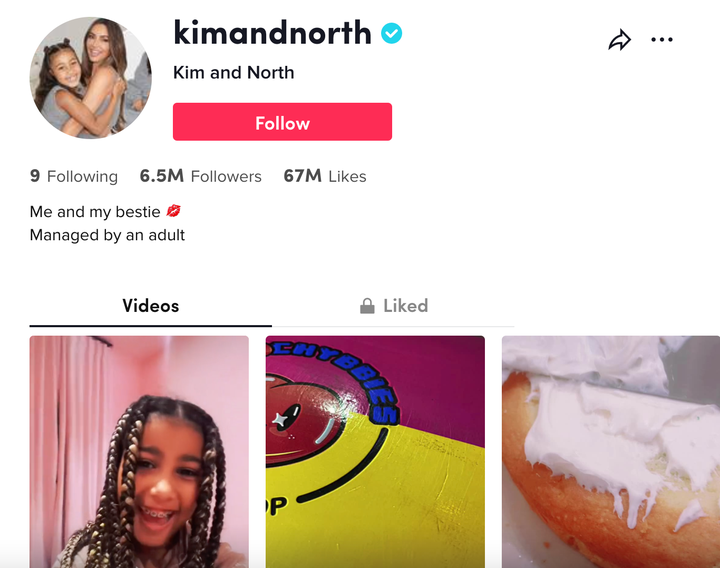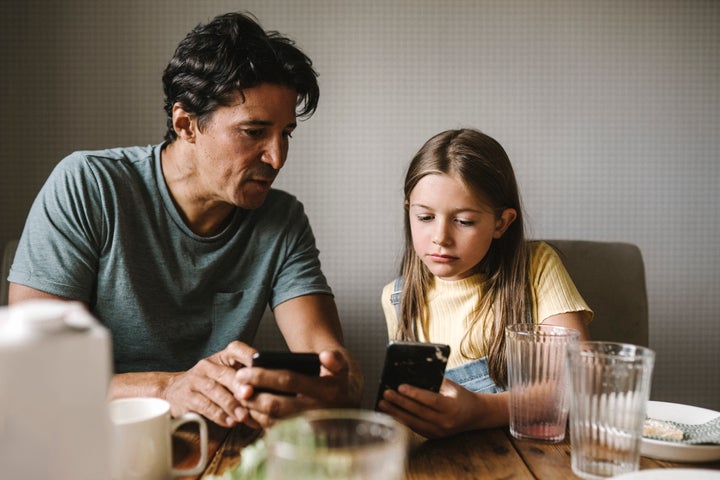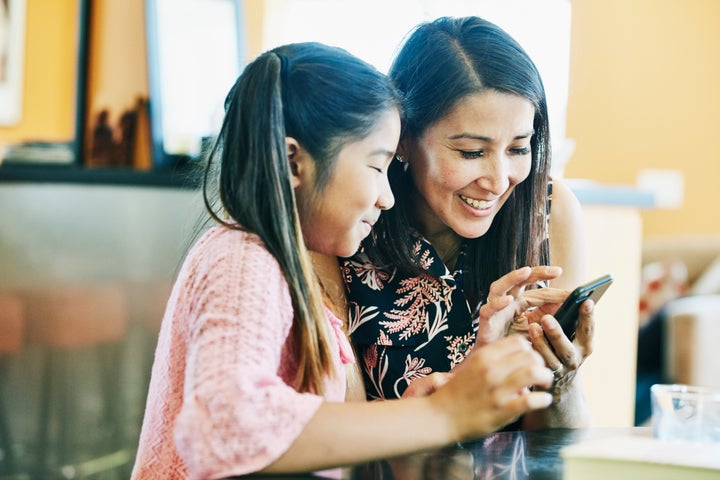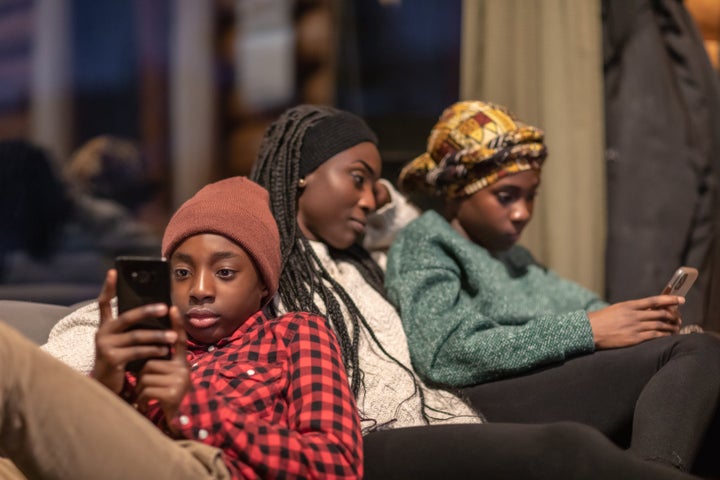One big point of contention in Kim Kardashian and Kanye West’s divorce is whether or not their 8-year-old daughter, North, should be allowed on TikTok.
Much to West’s chagrin, North already is.
Kardashian created the joint TikTok account back in November, and in that time @kimandnorth has amassed more than 6.5 million followers. (The age requirement for the app is 13, but the reality star sidestepped the rule by sharing the account and noting that it’s “managed by an adult”).
In a now-deleted Instagram post from February, West – who has legally changed his name to Ye ― expressed his angst over North having a TikTok account “against my will”.
In response, Kardashian posted an Instagram story explaining that she allows North to “express her creativity in the medium that she wishes with adult supervision – because it brings her happiness.”
Ye being Ye, it’s no surprise that wasn’t the end of the conversation.
After Kardashian and North posted a TikTok earlier this month, West revealed he’d just had words with his ex about social media.
“Hey everybody, I just got off the phone with Kim,” he said in a now-deleted video. “I told her to stop antagonising me with this TikTok thing. I said never again.”
“I am her father and I know y’all don’t respect fathers and the idea of family [but] I said I’m not allowing my daughter to be used by TikTok, to be used by Disney,” he continued. “I have a say so.”

While few people have over 15 million followers to complain to about co-parenting spats, like West does, plenty of parents have had similar arguments about when it’s the right time to allow a child on social media.
“Screen time is one of the main sources of conflict in families,” says Pamela Rutledge, a media psychologist and the director of the Media Psychology Research Center.
In the case of the Kardashians, “eight may seem young, but the Kardashians and Jenners have made an industry out of monetising social media and continually creating content,” Rutledge says. “It would be shocking if North didn’t find it appealing.”
Tweens with older siblings or with close friends with older siblings are likely to find social media appealing at an early age, too, she notes. And if they don’t have an account themselves, they’ll probably find ways to see the content anyway, Rutledge tells HuffPost.
“I tell parents the best way to protect your child is to have open and non-judgmental conversations about apps and content and take the time to invest in developing an understanding and agreement about what constitutes healthy media consumption.”
That’s advice based in reality, given how many kids are already on TikTok. Last year, 63% of Americans ages 12 to 17 used TikTok on a weekly basis, compared with 57% for Instagram, Forrester wrote in a blog post, citing data from a survey the research firm conducted.
Is there a “right” age to allow your child on social media?
Rutledge doesn’t believe there’s a “magic number” for the age at which a child is ready for social media.
“I don’t think social media is always the bogeyman parents think it is,” she says. “For most kids, what matters most is how technology is used, not how many hours.”
But experts like Jean M. Twenge, a professor of psychology at San Diego State University and the author of iGen: Why Today’s Super-Connected Kids Are Growing Up Less Rebellious, More Tolerant, Less Happy — and Completely Unprepared for Adulthood, thinks that even 13 is too young for social media, especially for girls.
“If you don’t have the app yourself, research it and download it so you can understand the lay of the land before your kid gets on it.”
- Keneisha Sinclair-McBride, clinical psychologist at Boston Children’s Hospital
“My research shows that teen girls who spend five or more hours a day on social media are three times more likely to be depressed than those who do not use social media,” Twenge tells HuffPost. (Research shows the link between social media use and depressive symptoms is stronger for girls compared with boys.)
These findings line up with Facebook’s internal research, leaked by a whistleblower and published last fall, which found that Instagram led to depression and body image issues, particularly among teenage girls.
US lawmakers and federal regulators have criticised TikTok in particular, citing practices and algorithms they say push video content that promotes eating disorders and even self-harm and suicide to young viewers.
Most experts we spoke to noted the harms of social media but understood the predicament that parents of preteens are in when everyone in their kid’s grade is on TikTok. For parents feeling the pressure, Keneisha Sinclair-McBride, a clinical psychologist at Boston Children’s Hospital, thinks 13 is generally an acceptable age to get on the app with a private account.
“I would say families should try as much as possible to wait until middle school, though,” she tells HuffPost. “My feeling is children younger than the middle school years should really only be interacting with social media in the presence of a parent or guardian, or creating age-appropriate TikToks on a parent-controlled account.”
The bottom line is, using any social network can be risky, but parents should seize the opportunity to help their kids develop a healthy relationship with digital spaces rather than have their preteens go it alone. Below, child psychologists share the best-practices advice they give TikTok-wary parents.
Get on the app yourself
Ignorance is definitely not bliss when it comes to what your child is seeing on their social feeds, Sinclair-McBride says.
“If you don’t have the app yourself, research it and download it so you can understand the lay of the land before your kid gets on it,” she says. “Make sure to research parental controls and find out information on privacy concerns.”
Look on the bright side: You may end up going down some rabbit holes of really interesting content that you want to follow yourself. (May we recommend Job TikTok? It’s fascinating.)
Don’t just think age. Think about your child’s maturity level, too
On its official site, TikTok says that “the TikTok experience is for people 13 and older,” but really, it’s up to you to determine if your child is developmentally ready to be on the app. Your child’s actual age and their developmental age are not always in sync, said Kate Eshleman, a paediatric psychologist at Cleveland Clinic Children’s.
“Parents and caregivers should consider the temperament style and any mental health concerns of their children,” Eshleman tells HuffPost. “For example, children that are highly impulsive, either within an expected range for development or due to a diagnosis, may be more likely to mimic some of the dangerous pranks before being able to stop and think through whether it’s a good idea.”

Children who tend to be anxious may fixate on troubling or newsworthy things they see on the app, Eshleman says, and kids who are experiencing symptoms of depression may become highly distressed by content they see.
Every child is different, which is why it’s so important to do regular check-ins with them, asking what content they’re enjoying and what may be bothering them.
“This is especially important in times like now, when kids may be seeing horrific footage from war in Ukraine,” Rutledge says. “You want kids to feel comfortable talking about what they see.”
Have conversations about the issues they may encounter online and what constitutes “good” and “bad” content
Before hopping on any app, kids need to be given the tools to know how to navigate online spaces. That means they know not to share personal information and that they recognise online “stranger danger” and what to do if someone approaches them inappropriately or bullies them in the comments or over direct messages.
“I’d tell parents to specifically talk over the privacy settings, the dangers of sharing personal information and the searchability and permanence of the internet,” Rutledge said.
Go over what content creators are appropriate to follow, too, and the types of videos and photos that should never be posted. Though much of the content on TiKTok is posted just for fun, there are, of course, darker sides to the apps, from pro-eating disorder content to things like the “blackout challenge,” a dangerous trend on TikTok in which teens film themselves holding their breath or choking themselves until they lose consciousness.
Talk openly and honestly to your kids about what kinds of posts and comments add value to the internet (and which categorically do not) and what it means to be a good digital citizen.
Help them find age-appropriate, positive content
So far, we’ve addressed the darker side of TiKTok, but it’s important to note that the app is chock-full of funny, informative, nostalgic, body-positive and wonderfully creatively videos, too.
Steer your kids in the right direction by helping them curate a feed that’s uniquely “them” and brings out the best in them. You might ask your kid what they like about the people they follow: Is it the TikTokker’s creativity they’re drawn to? The person’s sense of humour or the good vibes your kid feels after watching their videos? Pinpoint those qualities, then help them find similar content creators together.

Establish a kid-friendly code of conduct
Work with your child to establish some ground rules for social media use. Maybe they need to get your approval before they hit “send” on a post. Maybe you’re not OK with your child having their own private account but are open to a joint account.
Maybe they can only go on using mom or dad’s phone. In a Romper article published in February, freelance journalist Jennifer Barton said that’s the only way her TikTok-obsessed 8-year-old is allowed to go on the app.
“My daughter’s account is still on my phone, and she accesses it about once or twice a week, for 30-45 minutes. She scrolls through her friends’ videos, makes comments, sends herself dance routines to learn,” Barton writes. “Occasionally, she posts videos she’s made: a sushi dinner, a shopping excursion, something featuring her ‘aesthetic’ (think pastel, arty pics of herself half-covered by a blue Instax camera).”
Larry Rosen, a professor emeritus in the psychology department at California State University, Dominguez Hills, and the co-author of The Distracted Mind: Ancient Brains in a High-Tech World, thinks that’s a smart approach.
“I tell parents now that they need to ‘own’ the social media and give kids control for set periods of time under parental control,” he says. “The device used should be in a public area of the home, and if it’s a portable device it needs to be put away until the parent can be available to monitor.”
Of course, even the best laid TikTok usage plans can go wrong. Take Kardashian and North as an example. Last December, the famous 8-year-old got lectured by her mum after giving her followers an unfiltered tour of her home as she ran around the house.
Lean into the rules for young users set by the social media platforms
Some rules, you can tell your kids, are already established and enforced by the app they’re on. (Of course, any kid can bypass age limit rules by doing a little simple math and saying they’re older than they are, but TikTok, for instance, does have different settings for different ages.) As Common Sense Media points out in its parental guide to TikTok:
Users under 13 can’t post videos or comment, and content is curated for a younger audience.
For kids age 13 to 15, accounts are private by default; only friends can comment on videos, and other users can’t “duet” with your videos.
Only users 16 and over can livestream and use direct messaging, and only users over 18 can buy, send, or receive virtual gifts.
TikTok also offers tools for parents to limit how much time kids spend on the app and what kids can see. Parents can also turn on “restricted mode” to reduce mature content or “family safety mode” to pair their account with their kid’s to control settings.
Instagram is in the process of introducing similar parental controls in the US and eventually globally. According to the Wall Street Journal, the app recently rolled out a feature that lets parents see how much time their teens spend on Instagram and set limits. Parents will also reportedly be able to view what accounts their teens follow, as well as who follows them.
If your kid is not mature enough for one app, find an alternative
Don’t forget that screen activities like gaming or video chat are always an option if your kid is not yet ready for TikTok or Instagram.
“If your child wants to communicate with his/her friends, FaceTiming or playing online games together like Minecraft may be better choices,” Twenge says. “They are in real time, focus on relationships with friends, and avoid the performative nature of social media. FaceTime doesn’t have influencers.”
Don’t belittle your kid’s interests or follow list
Unless it’s problematic, don’t make fun of or belittle your child’s online interests, their favourite influencers or their content. Sure, Spencer X’s beatboxing on TikTok or @richcaroline’s Cher-Horowitz-from-Clueless act aren’t for everyone, but let your kids have their “faves” in peace.
“Nothing shuts the door faster than judgment,” Rutledge says. “You want kids to feel they can come to you if they have a problem so you can provide solutions or a sympathetic ear – not judging their favourite influencers establishes a pattern of support.”

Stay realistic and be sensitive to your kid’s reality. Much of tweens and teens’ social lives are conducted online
Depending on your age, you may have had basic email and maybe AOL Instant Messenger at school, if you were lucky. It’s easy to forget that for kids today, their social lives aren’t bifurcated into “offline” and “online” like they were back then.
“Friendships, skill-building, social support, homework assignments and social capital can all occur in between dance videos,” Rutledge says. “The best way to protect kids is to teach them critical thinking and media literacy so they can evaluate content and information and have a better understanding of the implications of their behaviour in a digital world.”
Rutledge warns parents not to get suckered into investing in parental “spying apps” that she believes “prey on parental fears and technophobia.”
Not only can your tech-savvy kid get around those, they’ll likely feel disrespected or distrusted by you.
If you want to keep your kids safe and socially in tune with the rest of their peers, learning side-by-side and engaging with social media together is your best bet, Eshleman says.
“It’s so important to remember that all of this is much easier said than done,” the psychologist says. “Talk with your children about why they want social media, what they plan to do with it, and share your concerns. Keeping the conversation open, about all things, will be beneficial to the parent-child relationship.”
